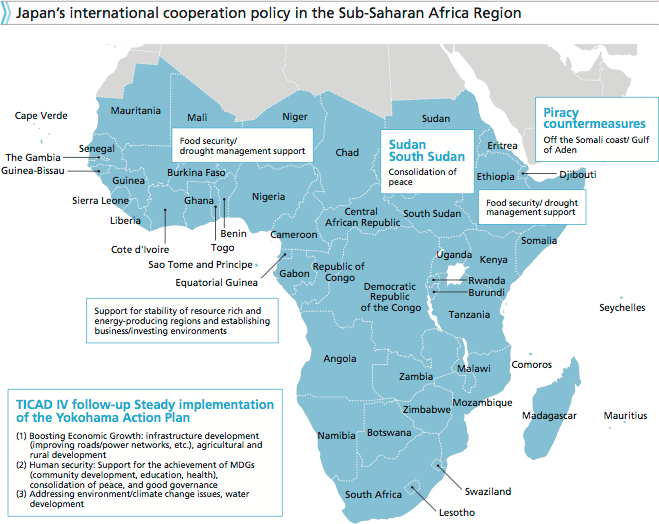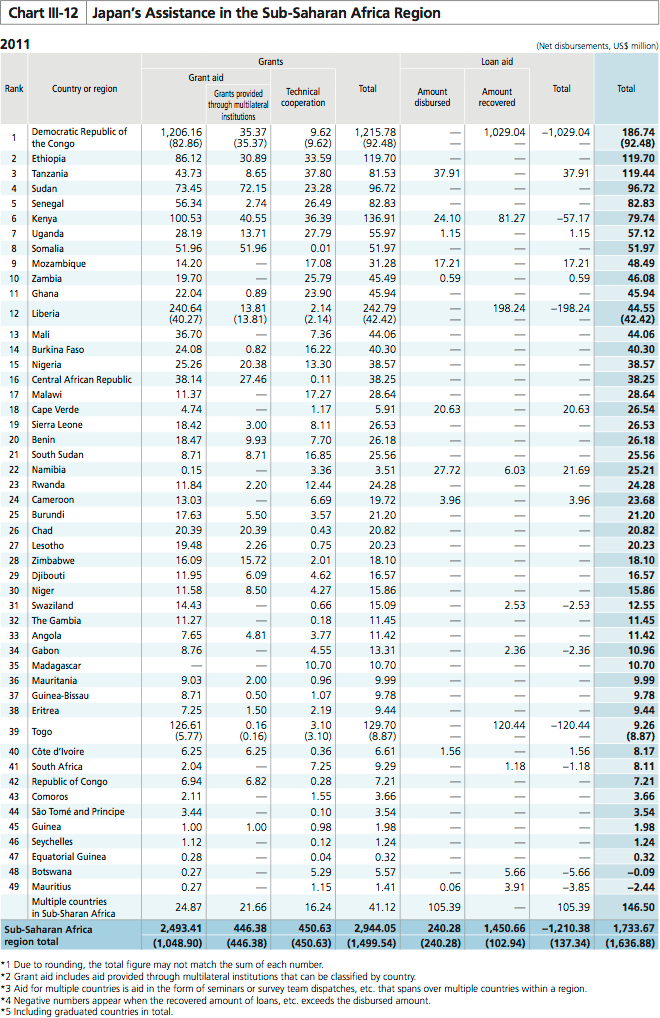Japan's Official Development Assistance White Paper 2012
5. Sub-Saharan Africa
Africa, particularly the region located south of the Sahara Desert that is referred to as "Sub-Sahara," continues to face serious problems of poverty. The majority of Sub- Saharan African countries (33 of the 48 countries) are Least Developed Countries (LDCs), and approximately half the population lives at or below the poverty line of $1.25 per day. In addition, many of the countries in the region face civil war and other conflicts, refugees, famine resulting from drought, the spread of infectious diseases such as HIV/AIDS, and other serious problems that hinder development, and require a significant amount of aid from the international community. These problems in Africa are critical interests of the international community in such forums as the UN Security Council and, the G8 Summit.
At the same time, Africa is blessed with abundant natural resources, and has achieved remarkable economic growth in recent years. Being a "continent full of hope and opportunity," Africa is drawing more and more attention from the international community.
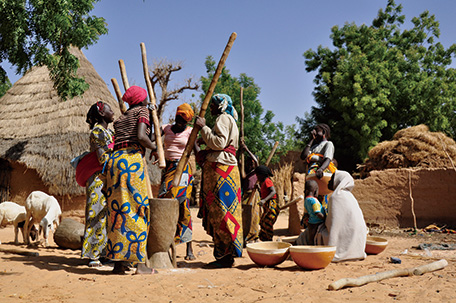
Nigerien women thrashing millet, their staple crop, with a mortar and pestle. (Photo: Seico Tamai)
<Japan's Efforts>
Japan has proactively cooperated in efforts led by African countries to address development issues through the Tokyo International Conference on African Development (TICAD), which is based on the fundamental principle of Africa's ownership as well as international cooperation (partnership). In May 2008, 15 years after TICAD was launched in 1993, TICAD IV was held in Yokohama. In May 2011, the Third TICAD Ministerial Follow-up Meeting was held in Dakar, Senegal. At the meeting, Japan stated that it would continue taking an active role in enhancing peace and stability in Africa, and expressed its unwavering determination to faithfully implement the TICAD IV pledges, overcoming the Great East Japan Earthquake. This received high praise from participated countries and organizations.
At the UN General Assembly general debates in September 2011, then-Japanese Prime Minister Yoshihiko Noda announced that Japan planned to host TICAD V in June 2013. At the Fourth TICAD IV Ministerial Follow-up Meeting in Marrakesh, Morocco in May 2012, participants from many countries praised Japan for its consistent execution of the Yokohama Action Plan and began looking ahead to TICAD V, discussing issues on which TICAD V would focus. Participants in TICAD V will continue to support Africa’s own efforts to make its economic growth in recent years more robust and spread the benefits of that growth in every corner in the society.
Japan also contributes to efforts to achieve peace and stability in the African region. For example, assistance for Sudan and South Sudan was taken up as one of the priority areas at TICAD IV and also a good example of assistance for consolidation of peace, which emphasizes as one of the important pillars of Japan's African policy. At the Third Sudan Consortium Conference held in Oslo in 2008, Japan announced additional assistance of approximately $200 million for the immediate future. This assistance bears in mind (i) the balance between Sudan and South Sudan, (ii) the gradual shift of Japan's assistance from the early recovery humanitarian stage to the reconstruction and development phase, and (iii) rectification of regional disparities. As of August 2010, approximately $220 million had been disbursed. In particular, considering the referendum on the independence of Southern Sudan held in January 2011 to be the culmination of the process of implementation of the Comprehensive Peace Agreement (CPA), Japan has been working for the consolidation of peace in Sudan, for example, with emergency grant aid amounting to approximately $8 million for the referendum. Japan has also been collaborating with international organizations and Japanese NGOs to provide food assistance and support for repatriation and reintegration of refugees in addition to support for basic human needs and infrastructure improvement, etc. in recent years. (See this for the section on Sudan and South Sudan)
Furthermore, Japan supports presidential elections and others to facilitate the democratic political process and consolidation of peace. Many elections took place in Africa between April 2011 and March 2012, and Japan collaborated with the UN Development Programme (UNDP) to provide a total of $9.2 million assistance to provide ballot boxes and other equipment for elections and improve the capacities of election administrators in Liberia, the Democratic Republic of the Congo, Guinea-Bissau, etc. This support contributed to implement democratic elections in these countries.
In FY2011, the Horn of Africa (the northeast part of the African continent consisting of Somalia, Djibouti, Ethiopia and Eritrea) was hit by a large-scale drought for the first time in 60 years. Meanwhile, the Sahel region including Mauritania, Niger, Burkina Faso, and Chad (the area in West Africa at the southern tip of the Sahara Desert) struggled through worsening public security and drought. Japan provided urgent food assistance based on needs in each place in both cases.
●Tanzania/Rwanda
Project for Construction of Rusumo International Bridge and One Stop Border Post Facilities
Grant Aid (August 2011 - Present)
The Central Corridor is an international artery that runs by the south side of Lake Victoria, connecting the Indian Ocean port of Dar es Salaam, Tanzania to the Rwandan capital of Kigali and is a vital economic corridor in the East African region. Rusumo Bridge spans the Tanzania-Rwanda border and is a critical point along the corridor for the distribution of goods between the two countries. However, it is not able to handle the increased traffic that comes with expanding trade because of its narrowness and deterioration by aging.
This project will serve to replace the decrepit Rusumo International Bridge and construct one-stop border post (OSBP*) facilities between Tanzania and Rwanda to facilitate smooth and efficient cross-border procedures. This will ease restrictions on the weights and speeds of vehicles crossing the border at Rusumo and shorten the procedures for crossing over. It is also expected to reduce transportation costs, help expand trade and investment between the two countries, and eventually contribute to the economic development of neighboring regions including landlocked Burundi and the Democratic Republic of Congo.
At TICAD IV in 2008, Japan pledged to support regional infrastructure in the African region and expand the OSBPs in order to streamline the border-crossing procedures and make an efficient logistic network. This program is a manifestation of the Japanese government's pledge to improve the African regional road network and maintain facilities for the simplification of customs procedures.
(As of December 2012)
*OBSP: One-stop border post is an efficient framework that two bordering countries collectively conduct cross-border procedures such as immigration control and customs inspections at land borders.
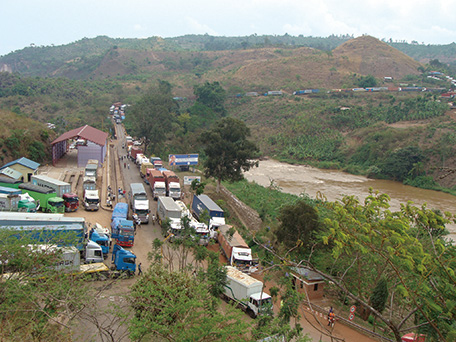
Rush hour (Photo: JICA)
●Senegal
Thies Health Center Improvement Project
Grant Assistance for Grassroots Human Security Projects (March 2011 - Present)
Thies Health Center is a public health care facility established in 1975 and located about 70 km east of the Senegalese capital of Dakar. Many poor people use this center because its medical fees are lower than those of nearby regional hospitals and private clinics. However, it is difficult to treat many patients there because the building, built in the 1950s during the French colonial period, is very small and extremely decrepit.
The Japanese government, through Grant Assistance for Grass-Roots Human Security Projects, implements the Thies Health Care Improvement Project in collaboration with CSR activity of the Mitsubishi Corporation's Senegal Office as part of the Public-Private Partnership. The Japanese government built a dentistry facility of the center while Mitsubishi built an X-ray facility. Connecting economic cooperation activities from ODA with corporate activities of a public nature should improve publicity as "Visibility of Japanese Aid."
(As of December 2012)
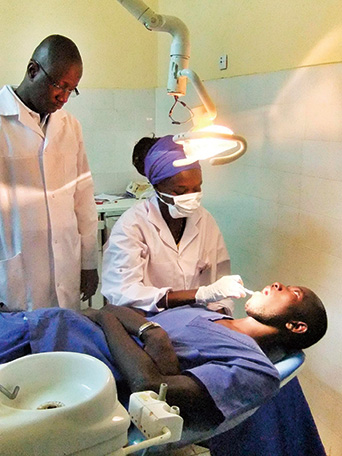
Dental operatory built as part of the project
